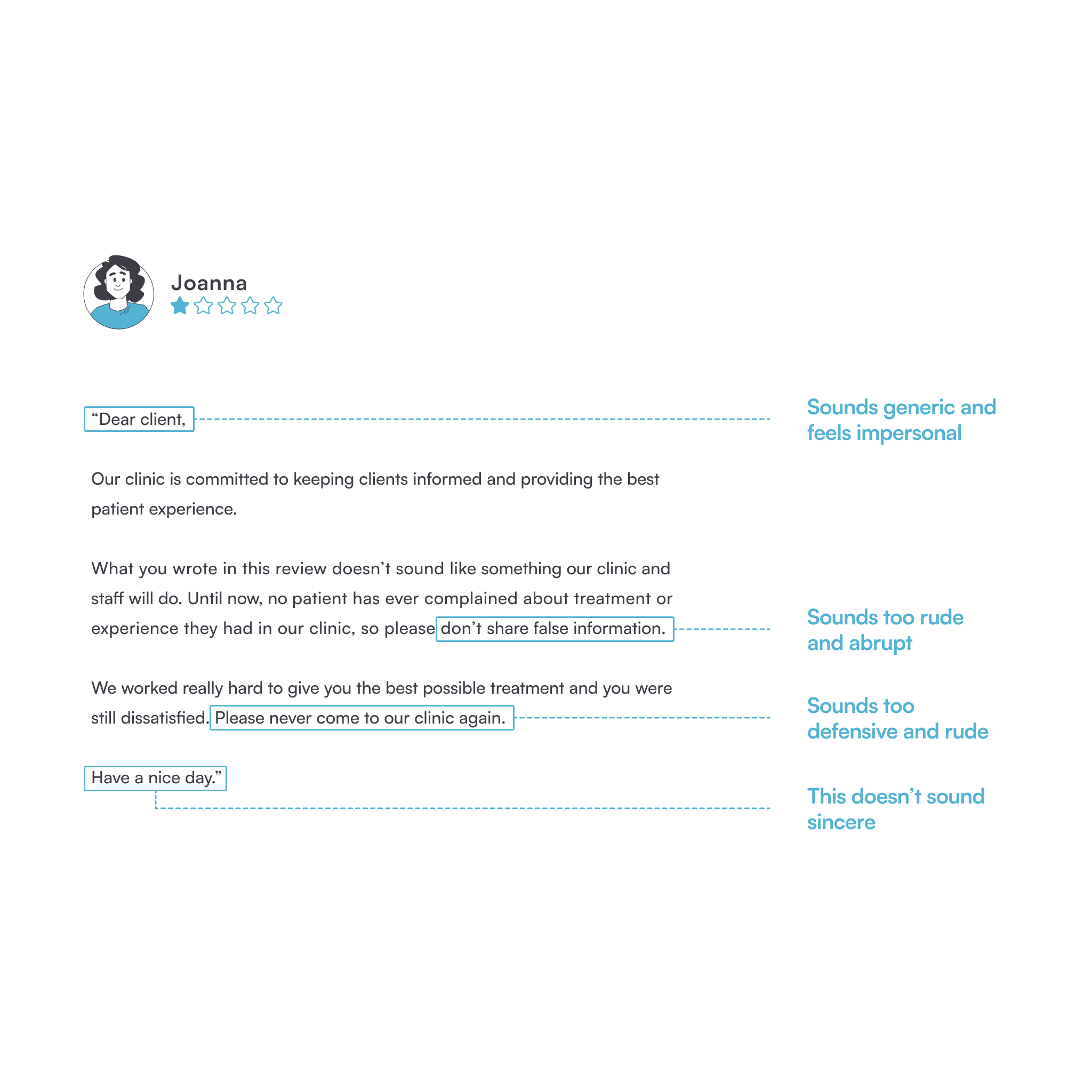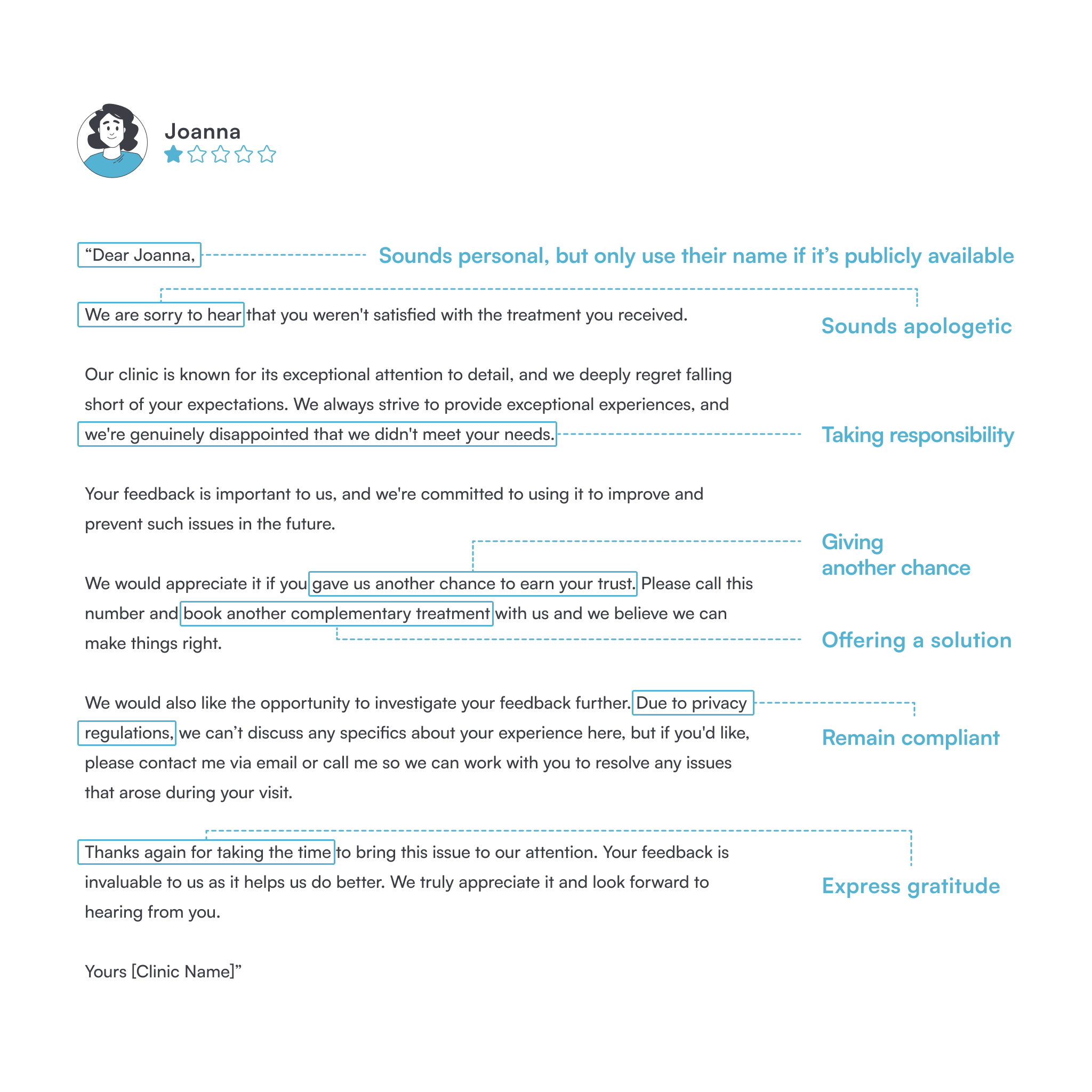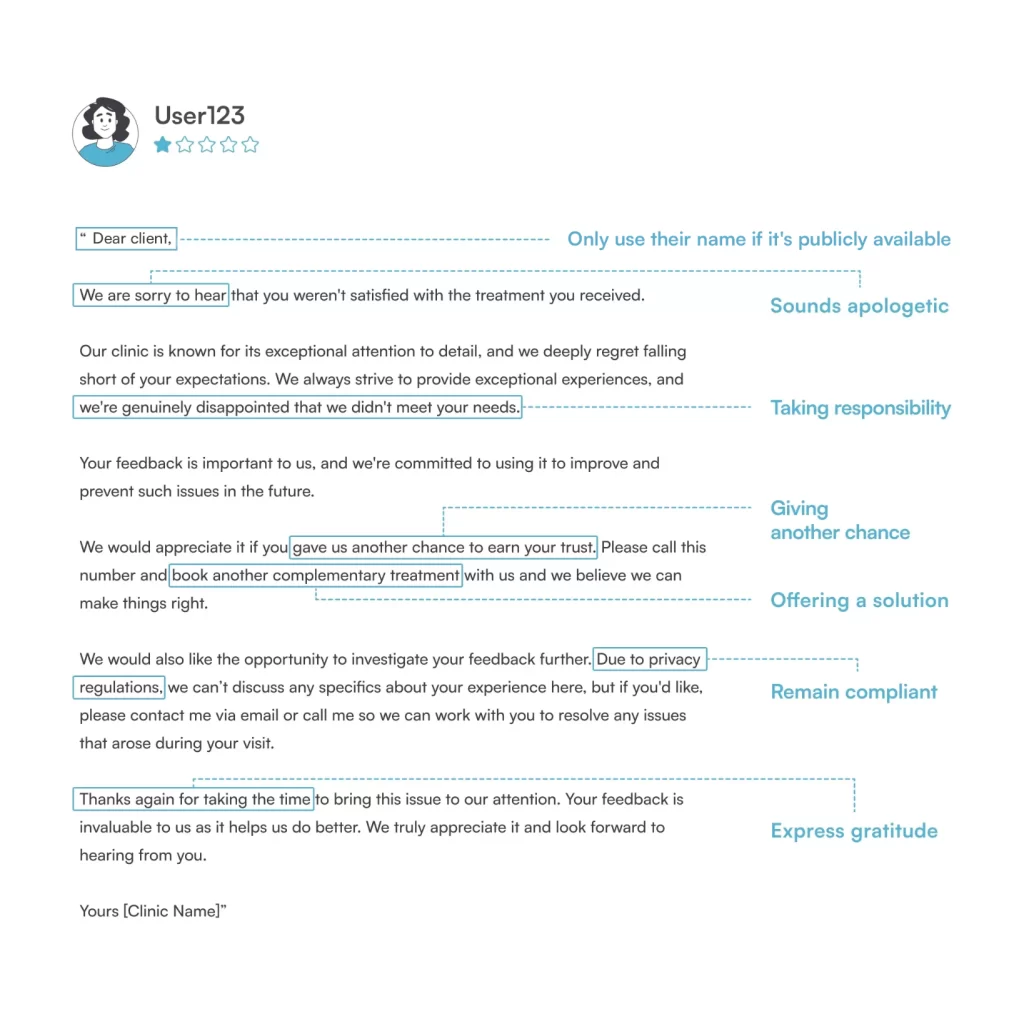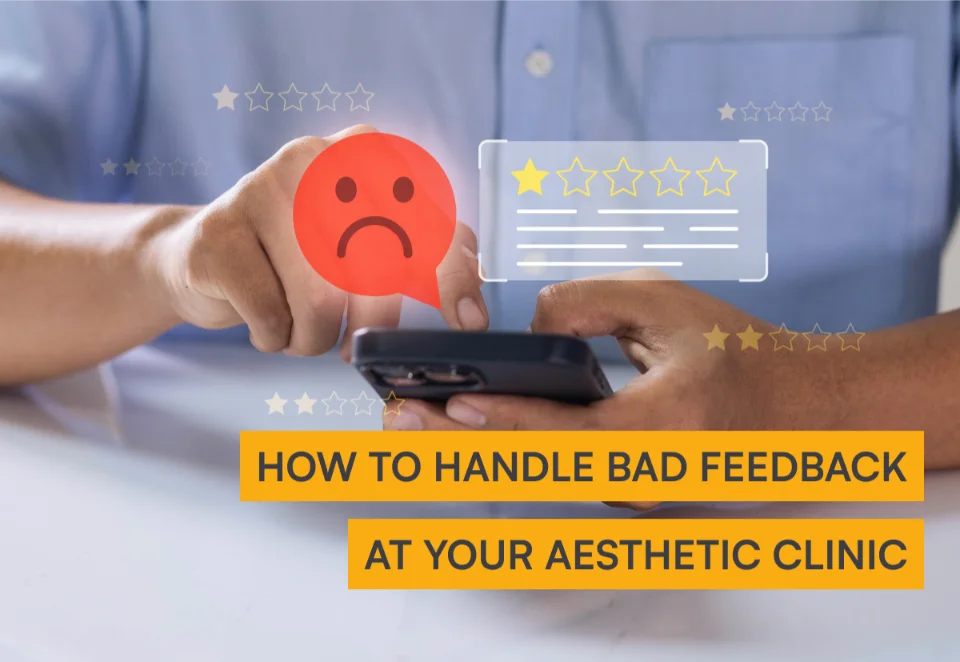Reviews are a double-edged sword – while they offer a raw glimpse into your clients’ experiences, a single negative review can cast a long shadow over your aesthetic business’s reputation.
But… getting negative feedback isn’t the end of the world. In fact, how you handle it makes your aesthetic clinic look even more credible.
The best way to deal with any potential damage caused by negative feedback is to have an action plan in place. Below, you’ll find out how to approach responding to negative online reviews and show that you value client feedback.

Why is patient feedback so crucial?
Reviews can be a powerful tool to build trust with potential clients.
Having more reviews on your website and Google makes it easier for potential clients to find and choose your clinic, which helps expand your client base.
Think of it this way. The last time you were planning to book a hotel or make a reservation at a new restaurant, what did you do first?
Chances are, you searched for Google reviews to ensure it was a worthwhile choice, didn’t you?
Reviews can also have a positive impact on business growth, as they help you:
- Gain insights into your aesthetic clinic’s performance
- Gauge client satisfaction
- Assess your online reputation
- Improve your services and online presence (two birds, one stone, right?)
It’s important to mention how reviews have an impact on SEO, particularly for local businesses. The more positive reviews you have, the greater the likelihood that search engines will show your aesthetics clinic in relevant searches.
That means you’re more visible to potential customers!
How to encourage more patients to leave feedback?
As we’ve seen, reviews matter a great deal in the aesthetic industry. Therefore, it’s important to actively encourage clients to leave reviews.
If you’re facing challenges in inspiring clients to pen down their thoughts on their experience, here are a few effective ways that might help you:
- Ask your clients to leave a review right after their appointment
- Automate the review request process – send them an automated email or SMS after they check out from your clinic
- Add comment boxes at your clinic’s front desk
- Highlight the significance of reviews – tell clients how it will you improve your services and help others make their decisions
- Make writing the reviews as simple as possible – provide your clients the link where they should leave the review
- Offer an incentive such as discounts and credits
- Send follow-ups on your review requests to clients who still haven’t left a review
The psychology behind bad patient feedback
According to Miriam Ellis owner of Solas Web Design, there are various motives behind a negative review. It can be for the sake of revenge, to inform other customers, to get a response from the business owner, to get an apology, or as an assurance that something is being done to fix the negative experience, etc.
Like it or not, it’s simply a common human tendency to share negative experiences more readily than positive ones.
So, despite your dedicated efforts in managing your clinic, the hard truth is that negative reviews can and will become a part of your online presence.
In fact, as your business gains more visibility, the likelihood of getting bad patient feedback increases.
How negative feedback impacts your aesthetics clinic
Negative feedback can have strong and long-lasting consequences for your aesthetic clinic.
Here are three of the main ones:
Loss of potential clients
Research by BrightLocal found that 50% of consumers in 2024 trust consumer reviews as much as personal recommendations from friends and family.
You might also have heard that an unhappy customer shares their bad experience with 9-10 people. This stat originates from Coca-Cola research back in the 1980s, when negative comments didn’t spread as fast as they do today.
Now, people share feedback on social media, and with the possibility of a post becoming viral, one unhappy client can actually tell millions!
In 2023, people used social media on average 41 times to share reviews about products and services, and this number will only grow.
So, one unhappy client might equal a LOT of more new clients lost.
Damage the brand reputation
One bad review can drag years of effort and success to a halt, potentially damaging your hard-earned reputation with existing and potential clients.
And once your reputation has been damaged, it takes a lot more effort to restore it.
According to this opinion piece on Inc, it takes roughly 40 positive customer experiences to undo the damage of a single negative review.
To put it simply, if you want to have an overall rating of four stars, you’ll need four five-star reviews to make up for every one-star review.
Impacts search ranking
Search engines, such as Google, factor in the quality and quantity of reviews as a ranking factor.
If your aesthetics clinic has more negative reviews than positive ones, it signals to search algorithms that users may not have the best experience at your clinic, causing a drop in rankings.
Lower visibility in search results makes it much harder for potential new clients to discover your clinic when searching for aesthetic treatments in your area.
Bad patient feedback can be an opportunity to improve and grow your aesthetics clinic
However, if you handle the situation the right way, sometimes even a 1-star review is not at all bad – it only shows that your business is real.
All of us make mistakes, and your staff are no exception.
But what most people care about and will pay attention to is how you respond to it.
Do you try to protect your business and staff? Or do you side with the client and try to find a solution to their problem?
Receiving bad patient feedback doesn’t mean your aesthetics clinic is set for failure, it only means that there’s more room for improvement.
Take into consideration what the person who posted the review had to say about their experience and work on it so you don’t make the same mistakes in the future.
Why responding to negative feedback is important?
Negative feedback can feel like a blow to your aesthetics clinic, but it’s also an opportunity to turn things around.
How you respond to these reviews speaks volumes about your commitment to improving service and client experience.
Showing care for your clients
Responding to negative reviews does more than damage control – it shows current and potential clients that you take their feedback seriously and that you genuinely care about their experience. All of this makes them feel seen and appreciated, helping you forge long-lasting relationships.
Helping control the damage negative reviews can cause
Leaving negative reviews to pile up without a response can snowball.
Responding promptly allows you to take control of the narrative and save your business’s reputation. As we’ve seen, clients sometimes leave a bad review because they simply want to hear an honest apology, or genuinely want to let you know that something is not working in your clinic.
Your response helps to restore trust with dissatisfied clients and even turn their negative experience into positive outcome for both parties.
They might give your business another chance if they feel their concerns are acknowledged and addressed.
Elevating standards for staff and services
Negative reviews often pinpoint areas where improvement is needed.
Loyal clients don’t want you to fail. So if you see negative comments from long-standing customers, it can highlight specific issues that you may not have been aware of, offering a chance to raise your clinic’s standards.
Analyze your clients’ feedback to see if there’s a recurring theme. For example, if multiple reviews mention long wait times or a rushed consultation, it may indicate the need for better scheduling practices or more personalized attention from staff.
Assists with compliance
In industries like medical aesthetics and healthcare, regulatory compliance isn’t just about providing quality service and safeguarding patient data. It also involves properly handling and addressing client concerns.
When clients leave negative reviews, they often highlight specific issues related to their treatment, interactions with staff, or overall experience.
Responding to these reviews creates a paper trail that shows your clinic is actively engaging with and addressing client grievances.
This documentation can be critical in case of a HIPAA audit or CQC inspection of your clinic’s quality assurance processes.
How to respond to bad patient feedback: Steps for aesthetics clinics
Having a clear and thoughtful approach helps make the whole process of dealing with bad patient reviews a lot smoother.
Below are essential steps to guide your response to bad patient feedback and ensure that it strengthens rather than harms your clinic’s reputation.
Step 1: Respond promptly
ReviewTracker discovered that 53% of clients expect businesses to write a response to negative feedback within a week. 1 in 3, though, expect to receive a response in three days or less.
That’s why, while you need to respond quickly, you can still take a few days. It’s important to recognize that when faced with a bad patient review, both you and the reviewer may be upset.
Give yourself some time to let the emotions cool off, but make sure to respond within a reasonable timeframe with a thoughtful and measured reply.
Responding too quickly could potentially escalate the situation, leading to an online war of words, which doesn’t look professional.
So, by not responding right away, you not only have more time to craft a polite response that will sit well with the client, but you also give them time to cool off too.
Step 2: Read the review carefully and investigate
Research is important in every aspect of a business, and this also applies when it comes to responding to bad patient feedback.
So before you start writing a response, doing thorough research on why the negative review occurred in the first place is crucial.
You should ask yourself and find out:
- What did the client write in the review?
- What actually happened – talk to the practitioner they saw.
- Has anyone from the staff already contacted them?
- When did the client visit your clinic?
Once you figure out the root cause of the negative feedback, you’re ready to jump to the next step.
Step 3: Personalize the response
Don’t just copy and paste the responses you previously wrote to others, as this will paint a picture that you don’t care about the experience your client had in your clinic.
Your clients want to be heard individually, and they expect personalized attention, so craft a unique response for every negative feedback you receive.
Also, avoid using terms like “dear patient” or “dear client” when addressing the person who left the review.
These terms come across as overly generic and impersonal. However, it’s also important not to use their real name unless this is publicly available, as this could be identifying and breach confidentiality regulations.
Trust us – addressing them by name will make them feel valued!
❌ DON’T ❌
“Dear client,
It’s unfortunate that you’ve had this experience. Our clinic is committed to keeping clients informed and providing the best patient experience.”
✅ DO ✅
“Dear Joanna,
We are sorry to hear that you weren’t satisfied with the treatment you received. We always use high-end products for all of our services, and we’re disappointed that we didn’t meet your expectations on this occasion.”
Step 4: Acknowledge the client and take responsibility
Even if your clinic isn’t at fault, lose the ego and focus on empathy.
Instead, acknowledge the experience of your client and apologize for it.
An apology won’t be meaningful only to the person who left the review, but will also show to others who read your clinic’s reviews that you care for your patients.
According to The National Customer Rage Survey by Customer Care Measurement & Consulting (CCMC), in collaboration with W.P. Carey School of Business at Arizona State University, after receiving non-monetary compensation, like an apology, together with the monetary compensation, client satisfaction dramatically increased from 43% to 60%!
Another thing that’s important is to avoid making excuses.
Whether the unfortunate situation was uncommon for your clinic, a one-time occurrence, or just an off day, simply acknowledge the client’s experience and try to empathize with them.
Try to avoid canned responses that sound insincere. The non-apology — “I’m sorry you feel that way” – doesn’t necessarily sound genuine.
However, don’t forget to also mention something positive about your clinic in your response, and reassure them that your staff always upholds high standards when working with patients.
❌ DON’T❌
“What you wrote in this review doesn’t sound like something our clinic and staff will do. Until now, no patient has ever complained about a treatment or experience they had in our clinic, so please don’t share false information.”
✅ DO ✅
“We are so sorry to hear this. Our clinic is known for its exceptional attention to detail, and we’re genuinely disappointed that we fell short on this occasion.
Your feedback is invaluable to us, and we’re committed to using it to improve and prevent such issues in the future.”
Step 5: Remember to maintain HIPAA compliance
Remember that HIPAA rules apply to all patient interactions, including responding to online reviews.
No matter how tempting it might be to correct misinformation in a negative review or explain what happened during a treatment, you must be extremely careful to avoid sharing any patient details.
Here are some tips for ensuring HIPAA compliance in your review responses:
- Don’t mention specifics about treatments or services – Even if the reviewer discusses their treatment, you are not allowed to confirm or deny the details, as doing so could violate patient privacy.
- Avoid any identifiable information – Don’t mention appointment times, procedures, or personal interactions that could identify the patient.
Keep the response general – Focus on acknowledging the client’s experience and offering to resolve the matter privately.
❌ DON’T ❌
“We apologize that your [specific treatment] did not meet your expectations. We’ve never had issues with [specific medical device] before, and your reaction is rare.”
✅ DO ✅
“We’re sorry to hear about your experience and appreciate your feedback. Please feel free to contact us directly at [phone number] so we can address your concerns.”
Step 6: Ask for a second chance and offer a solution
Don’t close the door to people who left negative feedback about your clinic. Instead, welcome them back with open hands.
Ask them to give you another chance and encourage them to come back to your clinic to “make things right.”
Offer them a solution to their problem – suggest they come to another appointment where you could rectify the perceived error. So for example, if they had anti-wrinkle injections offer them a corrective treatment.
However, if the situation is out of your control and the issue simply can’t be resolved, don’t make false promises, and instead offer them compensation if necessary.
❌ DON’T ❌
“We worked really hard to give you the best possible treatment and you were still dissatisfied. Please never come to our clinic again.”
✅ DO ✅
“We’re very sorry we failed to meet your expectations. We would appreciate it if you gave us another chance to earn your trust. Please get in touch with our team and book a complementary treatment and we believe we can make things right.”
Step 7: Take the issue offline and ask for more feedback
Breaking through to patients in an online setting can sometimes be challenging. They are probably upset, and even if you respond empathetically, they might still react defensively.
Instead, express your desire to address their concerns privately and suggest they contact you to give more detailed feedback on the situation and find a solution that works best for both of you.
This not only safeguards your reputation from further public scrutiny but also eliminates external interference.
❌ DON’T ❌
“Please give us more detailed feedback on your situation, otherwise, we won’t be able to help you.”
✅ DO ✅
“We would like the opportunity to investigate your feedback further. Due to privacy regulations, we can’t discuss any specifics about your experience here, but if you’d like, please contact us via email or call us so we can work with you to resolve any issues that arose during your visit?”
Step 8: Close your response with a “thank you”
You might wonder why you should express gratitude to a patient who might’ve potentially harmed your business with their negative review.
But you must remember that other people are reading the reviews, too, and you would want to show them that you appreciate honesty.
Client feedback can also help you prevent more issues from happening in the future, so the smart thing is to thank the reviewer for helping you improve the operations in your clinic.
Remember, the conclusion of your response holds as much importance as the rest of it.
❌ DON’T ❌
“Have a nice day.”
✅ DO ✅
“Thanks again for taking the time to bring this issue to our attention. Your feedback is invaluable to us as it helps us do better in the future. We truly appreciate it and look forward to hearing from you.
Yours [Clinic Name]”
How not to write a response to bad patient feedback
The following is an example of a less-than-ideal response to negative feedback. The introduction is overly generic and lacks personalization, which makes the client feel like a faceless number in a spreadsheet.
Additionally, the tone is curt, defensive and dismissive, failing to acknowledge the client’s negative experience. Responding in this way not only ruins the client’s trust but almost guarantees they won’t come back.

How to write a response to bad patient feedback that is also HIPAA compliant
Below is an example of what a good response to negative feedback should look like.
First, the clinic addresses the client by name (Remember to only use the client’s name if it’s publicly available).
Then, it takes accountability for the client’s bad experience and offers a solution to make up for the inconvenience. At the same time, it takes care not to reveal any details and remains compliant.
Finally, it thanks the client for bringing the issue to their attention and invites them to continue the discussion.
The overall tone is warm, empathetic, and professional, encouraging the client to feel valued and confident in continuing their relationship with the clinic.

A response where the client’s name is publicly available

A response where the client’s name is not publicly available
How a practice management software can help you manage reviews
A robust practice management software system streamlines the review management process. It automatically builds requesting reviews into the booking process.
After a client has had an appointment, the system prompts them to leave a review – and it also sends reminders to those who haven’t provided feedback after some time.
You’ll receive the reviews clients leave directly into the software, which is great because you won’t miss any client reviews.
Manage negative reviews at your aesthetic clinic with Pabau
Receiving negative reviews isn’t cause for celebration, for sure.
A single negative review has the power to disrupt all your clinic’s operations and, in the worst-case scenario, leave your clinic empty.
Pabau won’t let that happen. 🛡️
With an all-in-one practice management software like Pabau, you can choose which reviews you want to publish online and which reviews you want to keep only to yourself.
If you want to take even more control over your reviews, Pabau’s advanced marketing features not only allow you to showcase your social proof online on your own terms, but it can also direct people to publish their reviews on Google.
Boost your clinic’s presence on Google, increasing your visibility and drawing in more potential clients. More eyes on your clinic means more new clients walking through the door!
Book a demo with Pabau and see how we can help you shine online.🌟




